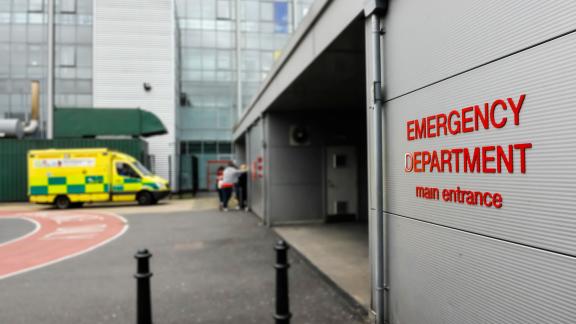Under pressure: NHS priorities this winter

Key points
- Ahead of the release of the monthly NHS performance statistics, we surveyed NHS leaders to seek their views on current pressures on the front line, where pressures lie and what measures the government and its national bodies could introduce now to help.
- Nine in ten NHS leaders say that current demands on their organisation are unsustainable, with just under nine in ten saying that a lack of staffing in the NHS as a whole is putting patient safety and care at risk.
- Leaders called for the government and national bodies to deliver more support for social care to ensure effective discharge arrangements are in place. They have also requested clearer messaging to the public about how difficult this winter is likely to be.
- We have gathered some examples of how staff across the system are working together to deliver more care under difficult circumstances.
- During the next few months the NHS will, to the best of its ability, continue to treat patients with the most urgent need and continue its commitment to deliver the highest possible quality service across the system. To achieve this, the health service needs four key actions in return:
- honesty from political leaders.
- boosting the booster programme.
- letting local leaders lead
- bolstering the social care sector.
- We are asking political leaders to support and communicate public-facing messages on how the public can support the NHS, including the single most important step of getting vaccinated.
Introduction
On 11 November, NHS England and NHS Improvement published the monthly performance statistics for the health service in October, describing what is being delivered and what the demand for care looks like across the system.
In line with previous months’ reporting, the figures show that the NHS continues to be under severe pressure as it heads into winter, with record demand on urgent and emergency care, increasing elective referrals and rising bed occupancy rates. Beds are also being filled by medically fit patients who cannot be discharged because there are no domiciliary or care home places available for them. This is on top of mounting pressure on mental health services, community services, primary care and large increases in ambulance handover delays.
We have also published a summary and analysis of this data.
What does the service say?
In advance of the release of these figures, we surveyed NHS leaders to seek their views on what pressures feels like on the front line, where the pressures are, and what measures the government and its national bodies could introduce now to help. Our key findings, based on over 400 responses, found the following:
One primary care leader said:
“The NHS as a whole is under a pressure never before witnessed by this generation of clinicians. The gate keepers of this demand are general practice and unless this primary care crisis is addressed, the rest of the system will be destined to fail.”
A trust chief executive said:
“Systems are at breaking point and risk is unacceptably high (for) some cohorts of patients, be that in emergency, primary care, cancer or elective care (or elsewhere) but where is the honesty and openness about this?”
The NHS's continued commitment
The NHS is committed to working with the rest of the system to bring down waiting times for patients who are in line for elective care. This is ambitious and means the service working harder than ever, delivering around 30 per cent more by 2024/25 compared to pre-pandemic levels. This pledge starts now but will stretch the NHS during its busiest time: winter.
As ever, during the next few months the NHS will, to the best of its ability, treat patients with the most urgent need. It will also continue its commitment to deliver the highest possible quality service across the system, including in at the front door of the NHS - primary care - where more patients are being seen than before the pandemic, as well as mental health and community services.
It will work as a system and support staff who are exhausted and depleted, having already experienced a period of extreme pressure and given so much to the people they care for.
Amid the unrelenting pressures, staff are working harder than ever to support patients and serve local communities:
What is required from the government and its national bodies
In return for its continued commitment, the NHS needs help to ensure that in addition to meeting the most urgent care needs, it has capacity to start to treat the people who have been waiting the longest for care. This requires four key actions:
1. Honesty from political leaders
Although the Secretary of State has acknowledged potential increases to waiting lists, our survey results show that NHS leaders disagree with his further assessment and argue that pressures are currently ‘unsustainable’. The government needs to level with the public now and clearly articulate the size of the challenge that the NHS is facing and what they can expect this winter. The hard work and value the NHS is delivering needs to be recognised and safeguarded from the top.
2. Boosting the booster programme
As winter months lead to the increased transmission of viruses, easy access and a simple, flexible process to deliver vaccines at scale is our best line of defence. We need a concerted public communications campaign about the impact of not getting vaccinated on them and the wider population. We also need to make it easy for people to access the vaccination and to ensure our information systems are capable of sharing accurate data across the system, - so we know where the gaps remain and in what communities.
National programme leads need to make sure people have a choice of sites and easy access to information that is shared with their local GP - for flu vaccination, COVID-19 boosters and the ‘evergreen’ offer for first and second doses.
3. Letting local leaders lead
This winter will be about treating the most urgent needs while also tackling waiting lists. Local leaders from the health service, local authorities, social care and wider system who know their service and populations best, who deliver a complex portfolio of risk every day, must be empowered to do so. We call for leaders to be able to act in an agile way and change priorities as required, including postponing elective care without recourse to a national or regional team.
Bolstering the social care sector
As they have done throughout the pandemic, the social care workforce will play a critical role this winter in supporting people at home or in the community. Although the recent additional funding to help recruit and keep staff is welcome, we need to take stronger action to bolster the whole sector to continue delivering high-quality care for everyone who needs it. We also need to level the playing field and pay care staff the equivalent of what their NHS colleagues earn and reimburse them adequately for increasing costs, such as fuel.
What the NHS needs from the public
There are simple steps that the public can take to make the best use of NHS services this winter, while demand for care is at an all-time high. We ask political leaders to support and communicate these public-facing messages:
Get vaccinated
- Get your COVID-19 vaccinations. This is the single most important step you can take to protect you, your loved ones and the NHS. Being vaccinated means you are less likely to need emergency care, leaving NHS staff with more capacity to help other people this winter.
- Get vaccinated for flu. The jab could save your life and will help the NHS.
- Get a COVID-19 booster jab if you are eligible. After five months your original vaccination will start to have less of an effect on protecting you from serious illness if you get COVID-19, so it is vital that you top up your immunity when you are called to.
Do what you can to support your NHS
- Help stop the spread of COVID-19 by following government advice.
- Use your pharmacist to get help with minor health concerns.
- Use NHS 111 if you have an urgent medical problem and you’re not sure what to do.
- Make sure you don’t miss your medical appointment and if you need to reschedule give the service plenty of warning.
- Consider volunteering for local charities, and supporting people in your street and communities.
What comes next?
Looking at the response from the front line and where we are on the trajectory of demand heading into winter, it is clear that something needs to be done differently. Even the additional funding announced recently has come too late to provide much needed extra capacity to avoid health services becoming unsafe. Being able to free up capacity to tackle the huge backlog of care for people whose care was cancelled during the pandemic feels like a distant ambition.
We have been calling for action in the run up to winter, including for ‘Plan B’ measures to be introduced. Now is the time to face up to the scale of the fast-approaching challenge and work in partnership – the NHS, the nation and political leaders – to avoid stumbling into a winter crisis. It is in this way that the whole system will be able to achieve the best possible outcomes in the coming months.
How is the NHS performing?
View our analysis of the latest NHS performance figures for a rounded view of how healthcare services are coping under immense pressure.



